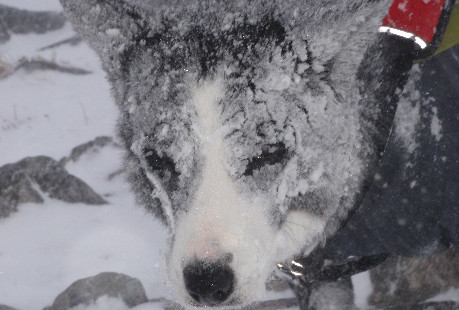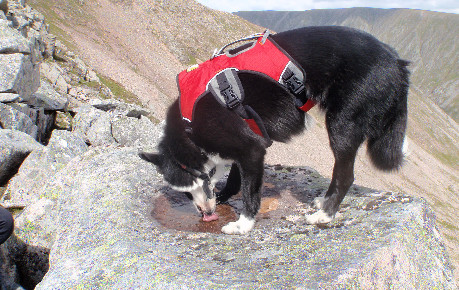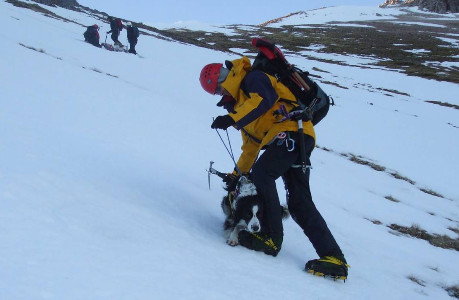
Like humans dogs are susceptible to the effects of heat and cold. You should know your dog well enough to know what sort of weather it can cope with.
Many dogs do not cope well with being out in the heat and you should assess how well your dog does walking in hot weather on low level walks before considering taking them into the mountains.
You should always plan your route to take in as much water as possible with rivers and lochans for the dog to cool off naturally. You will also need to carry additional water for your dog and encourage it to drink regularly. Wet food (available in pouches) is better than dried food during hot weather.
Many dogs have pink noses and these are prone to sunburn. A child’s Factor 50 waterproof sun cream should be applied before your walk and regularly throughout the day.

Many dogs do not enjoy being out in wet and windy conditions and they can get cold very quickly. A waterproof jacket can be vital to prevent your dog losing body heat and potentially succumbing to hypothermia. The symptoms of hypothermia in dogs can be very subtle. Signs of mild hypothermia include shivering and fatigue often followed by disorientation and difficulty or reluctance to walk. It is easier to prevent hypothermia by wearing an insulated and waterproof jacket than try to treat it.
Giving your dog suitable food and snacks will help to keep it warm during poor weather.
Equifleece jackets are ideal for short coated dogs who are prone to cold and are perfect for warming a damp dog up in the car on the journey home.
Crampons and paws don’t mix. It is important that your dog is trained not to walk under your feet and all members of your walking group must be aware of where they are placing their feet when there are dogs around. It is worth considering that if you are going to be walking in crampons for long periods of time whether this is a suitable and safe environment for your dog. They will struggle on steep neve with a danger of slips/falls and injury.
Dogs do not understand the danger of cornices. Whenever you are in terrain where cornicing is likely it is vital that your dog is kept on a lead.

Dogs’ paws are very susceptible to balling up in snow. Small snowballs will form between the toes and around the pads. With the impact of walking the snow will become compacted and painful for the dog to walk on. If you notice your dog limping or nibbling at its paws whilst walking in snow this is usually the cause and you will have to stop repeatedly to remove the snow from its feet. Prevention is better than cure and using Mushers Secret will prevent this
Long haired dogs will also be prone to snowballing. The liberal application of baby oil to their legs, belly and tail will prevent this happening.